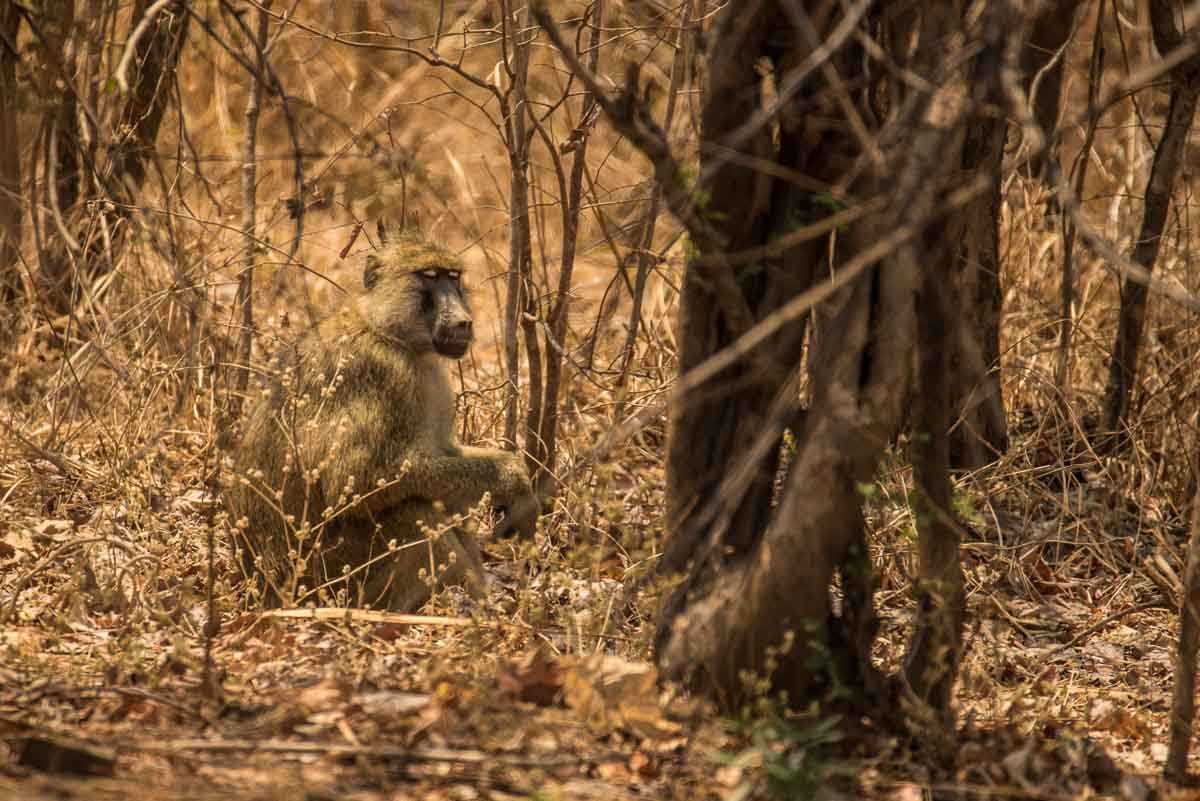
Note: I visited the Vwaza Wildlife Reserve in northern Malawi in October 2018 with Biosphere Expeditions. You can read more about my wildlife conservation expedition here.
Table of Contents
Arrival in Africa
Before I went to Malawi, I asked a friend who has extensive experience in Africa what I should pack. Her answer: “Patience. In Africa, things move at their own pace.”
Yes, they do.
Just entering Malawi at the Lilongwe airport is the first lesson. Luckily, our expedition organizer, Biosphere Expeditions, had prepared us in great detail for the entry process, including sending us in advance the visa application form with exact information on how to fill it out. (Just say “tourist!”) That saved a step at the immigration desks. Yes, desks. Plural.
There are four desks in a row in the small entry hall. The first is where you turn in your application form with your passport and the clerk certifies that you’re eligible for a visa. Then you shuffle to the next window (no orderly line up process) and pay your $75 USD fee (cash only, and correct change required) and get a hand-written receipt. You then scoot to the next window, show your receipt, and then they apply your one-page visa sticker to a blank page in your passport. Finally, and–and now you are in a line, sort of–you wait until you’re called forward to actually have your sticker stamped, and initialed, and you’re in. Forty minutes, at least.
Then you pick up your luggage, get it inspected. Twice. And wait in another line to change money. (Malawi tip number one: ATMs don’t really work like you’re used to.) For your $200 USD, in the recommended crisp new bills, you’ll get a stack of ragged Malawian Kwachas about an inch and a half thick. That doesn’t fit in your wallet.
Of course, the driver your hotel arranged to pick you up doesn't show up. Or maybe he left while you were in the immigration line. So, you hire another guy from among the dozen or so who are offering taxi service. I hired Rashid.
The next step is getting a SIM card for your phone, which is a bit of a process, too. But luckily Rashid knew the ropes. He took me to the Lilongwe shopping mall where, first, you buy the SIM card from one vendor. Then you take it to the phone company down the hall and fill out a form, show them your passport and visa, and they give you a code to activate your SIM over WIFI. Of course, neither the phone company nor the kiosk selling the card has WIFI, so you need to find that. You also need to buy scratch off cards with serial numbers that add balance to your account, so you can actually use your phone for calls and internet. An hour and a half for this, including lining up at the phone company.
After that, arriving at the hotel, checking in, taking a shower, was a breeze.
The following day, a fellow Biosphere Expeditioner and I hire Rashid again for a day’s tour of Lilongwe, which includes a tour of the Lilongwe Wildlife Trust animal rescue and rehab facility and a delicious vegetarian lunch at Veg Delight restaurant. The Wildlife Trust entry fee is 4200 kwacha, about $6 USD. My share of the meal, including two beers, is about $7. And hiring Rashid for four hours is about $20.
My impression driving around Lilongwe for a couple of days is of a flat city. We see no buildings taller than two stories, and bustling people are everywhere, sitting on shop stoops, walking along the road, chatting on corners, and generally looking very busy at some sort of elementary commerce.
Driving to Vwaza Wildlife Reserve
The next day is a more detailed intro to the country. We are picked up at the hotel for an eight-hour drive to Vwaza Wildlife Reserve where we are joining the Biosphere Expeditions group.
The roads are mostly two-lane highway, mostly in pretty good condition and we make good time. Unfortunately, I am not able to stop and take all the photos I would have liked of the passing panorama of Malawian life.
The road is constantly lined with people: men using sticks to herd their goats, women balancing huge packages on their heads, a congregation of about 50 sitting on the steps and bare ground around their church, roadside markets of everything from vegetables to batteries. A woman killing chickens. A couple of times we stop for cows in the road. Once we have to stop, exit the bus, and walk over gunny sacks that are soaked with disinfectant against transmitting hoof and mouth disease.
We stop for a roadside lunch and have our first real Malawian meal: a gooey white ball of maize paste called nshima, boiled with greens. We're offered ketchup for flavor.
The buildings along the road are of homemade red-brown clay brick with thatched roofs. The terrain, including the buildings, is all in shades of brown; there’s been no rain here in a while. The only color is the traditional colorful skirts of the women. It’s almost as if their clothing is the antidote to the monochromatic surrounds. As we climb up the plateau, though, a bit of green begins to show.
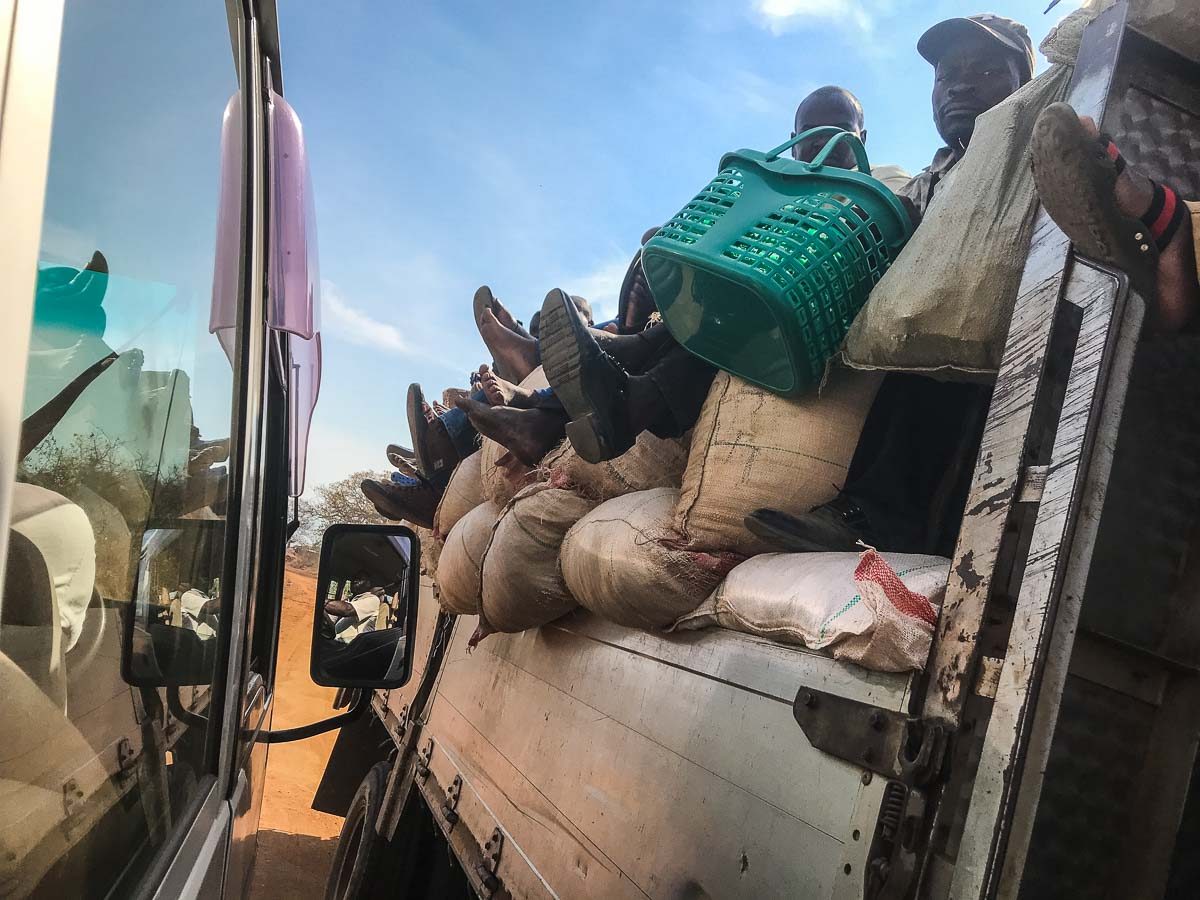
Once we’re out of Lilongwe, there are very few private cars seen on the road. Only commercial trucks, often stacked with sacks of goods, and topped with people hitching a ride. Evidently, this is how long distance travel is done in Malawi.
Painted on a large stone on the roadside: “Did you know bad leaders are voted into power by people who don’t vote?” I want to pick that up and carry it home.
Finally, we turn off the paved road onto a dirt road for the last 45 minutes into the Vwaza camp. We can’t roll up the windows of the van against the dust because it’s too hot. Next time I come to Africa, I’m going to remember to bring a bandana or Buff to cover my nose and mouth. The driver turns to tell me, “You’re in the bush now.”
At camp, finally, we are greeted first by a herd of elephants grazing in the grassy grove a couple hundred yards away and our first big African sunset off to the west.
In the Biosphere Expeditions camp
After dinner, our first introduction to the work we’re going to be doing here is the safety lecture, which obviously revolves around the potential dangers from the animals we’re going to be studying. We learn about mock elephant charges and real ones, and to never get between the hippos and their swimming holes, and to not corner baboons, and most important, to keep your eyes up and open at all times, especially when moving around camp at night. If you’re getting up to go to the bathroom, look both directions before stepping out of the tent. Both elephants and hippos were known to come into camp. (And they both did.) And, yes, snakes. Keep an especially keen eye out for them when in the bush. One of the naturalists, Karen, tells us of her experience of walking right up to a bush that was hiding a black mamba. And, yes, a cobra did come into camp one night. (Here is more info on dangerous African animals.)
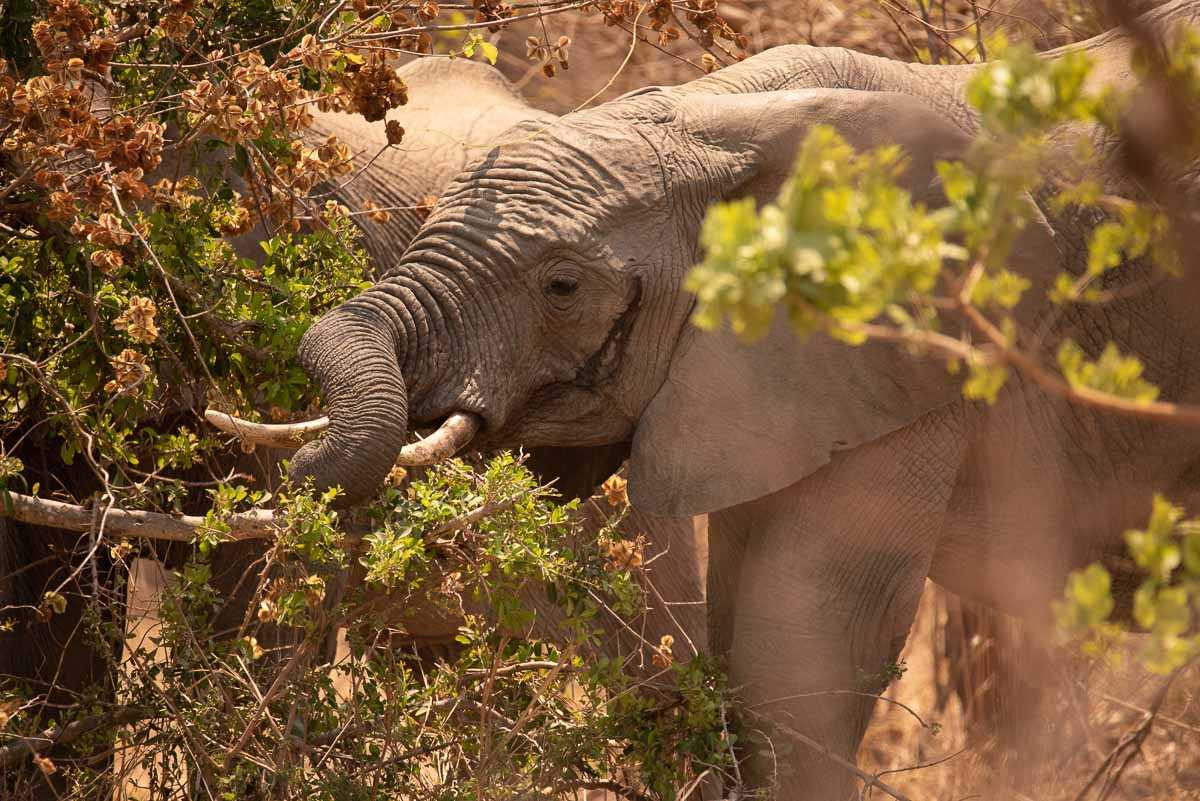
Day 2
The next morning starts with a lecture on the particulars of the bat project we would be working on, including an effort to build bat houses in populated areas with the aim of getting bats out of peoples’ homes, which is evidently quite a problem in Malawi because of the open construction techniques. Leaving a space between the top of the wall and the roof to let the air in also, not surprisingly, lets bats into the home, and leads people to have a rather aggressive bent for killing and removing them. Certainly understandable. Would you want rabies and a pile of bat guano in your house?
But bats are beneficial. Guano is a useful fertilizer in a country that has mostly poor soil for growing. Also, bats eat insects, particularly mosquitoes. And Malawi has a surfeit of mosquitoes.
We also learn today about the organization of our bush walks, or transects, and how to use the GPS units, laser range finders, and a compass to give precise locations on the animals we’d be sighting. I had a compass orienteering class way back when, so it is fun to get a refresher, and even more fun to finally put my compass to actual use.
We learn quite a bit about elephant behavior, and that they were in particular, “intelligent, emotional, and peaceful.” Unless you bother them, in which case you could look for “nervous” behaviors such us lifting the chin, foot swinging, trunk and tail twisting. If you are too close, ears will spread, the tail will stand up, the head will shake, and the trunk will swing. Sometimes they might pick something up and toss it. If any or all of these things occur, you are about to be faced, probably, with a “mock” charge. If they go silent and put their head down, that’s when you were in danger of a real charge, and you should back off in a hurry.
As Alex, our elephant expert, gives us the lecture, a small herd comes right into camp and starts denuding the closest trees. Sully, a young male in “musth”, meaning sexual or nervous arousal, gets particularly close and gives us our first real taste of what we are in for.
We conclude the day with our first animal drive, where we all pile into the expedition vehicles and drive off to the west and north roads around the camps, where we get our first look at the neighboring hippos. We also get our first view of a typical hippo behavior, which includes spinning their tail rapidly as they defecate, which has the effect of throwing their poo all over the place. Luckily we don't get close to that, although we do hear a story from one of the naturalists about a hippo doing that to her tent one night, which made for sort of a disgusting job the next morning.
Along the trail, Karen finds some leopard scat, which excites her immensely, because leopards and lions are rare in the Vwaza reserve. We also learn the difference between the terms scat (of carnivores) and dung of herbivores.
We spot a pelican, which also excites Karen a lot, because they also are quite rare in Vwaza.
Upon our return to camp, we are treated to the warble of a tropical boubou who lives in the thick bush right outside my tent. He ends up serenading both evening and night, although I get only the most fleeting glance of him in the almost two weeks there. I am only able to identify him through the expertise of my tent mate Harald, who turned out, luckily for me, to be quite a birder.
Day 3
The next day continues our training with Karen’s lecture on how the camera traps work. They’re favored by researchers because they’re noninvasive, and they’re much more likely to catch nocturnal animal movement. Oh, and poachers.
There are two types of cameras, both infra-red and white flash, and both have their advantages. The only visual evidence of a lion in Vwaza was captured by one of these cameras, and this led to further evidence of his movements by finding his tracks, and eventually collecting reports from nearby villages of his nighttime roars.
During the lecture, baboons troop right up to camp and start feeding right in the small bush area just outside our kitchen building. But the highlight of the natural world today is seeing a wasp sting a small caterpillar. I call Karen, who is an entomologist, over to see it. She explains that the wasp doesn’t actually kill the caterpillar. He paralyzes it and carries it back to his nest for the larvae when they hatch. That way, they have a first fresh meal, as the caterpillar is consumed alive. This won’t be our first evidence of cruel nature, I’m sure.
And tonight is the night we see the cobra behind Mandy’s tent.
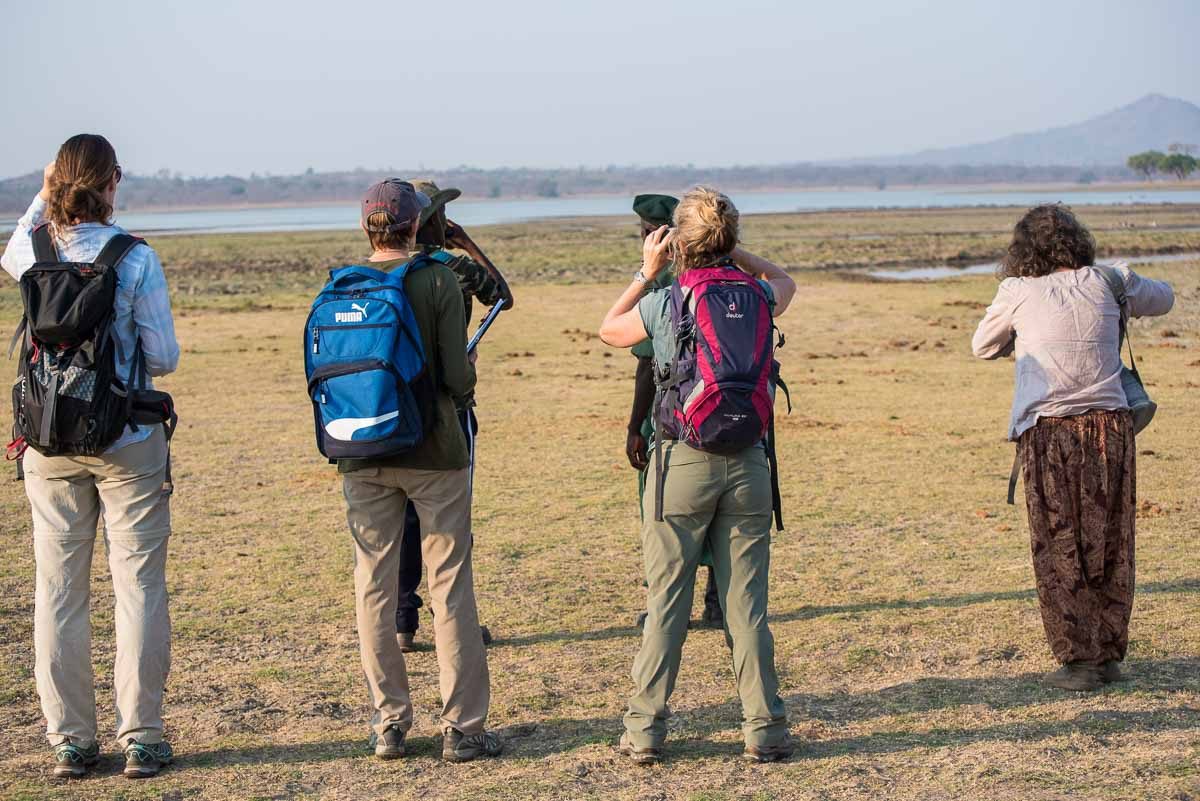
Day 4
Today, we’re up at 5 with the sun for a breakfast of eggs, toast, and sliced avocado, which is also my favorite breakfast at home. The planned activity, which I signed up for on the white board schedule yesterday, is a hippo walk with Pili, our only native Malawian naturalist. This will turn out to be my favorite activity over the next 10 days.
We start out walking straight out of the camp, accompanied by our armed park ranger guard Patson, across the mud flats to the north end of the lake, and then turn around to the south. Our first sighting of the day is two huge crocodiles sunning themselves on the shore. They’re too far off for a good look with anything other than very powerful binoculars, and my walkmates who have them assure me they are indeed crocs instead of just random lumps.
We continue our walk and see many groups of hippos, all bathing along the shore. The aim of the walks, or “transects” is to walk exactly 5 kilometers as measured by the GPS devices, and record on a form a count and location of all the hippos we see, and from our observations and some sophisticated statistical analysis done by computer programs written by people who got a lot further along in stats than I ever did, we can estimate closely the entire hippo population of the Vwaza reserve. Unfortunately today, as we got about 3.5 kilometers along our route, a few elephants on a transect of their own cut across our path, so we had to turn around.
On our way back along the shore, a solitary male elephant strides into our path. So, we have to detour again north into the bush up a hill and around to a road which leads back to camp. Pili explains that the lone elephant is leading a yet unseen herd, so it isn't just a matter of walking around him. We have to take about a three-kilometer detour downwind of the anticipated herd and round back to the lakeshore.
Along the road we find a mass of feathers that had once belonged to one of the guinea fowls we saw almost every day. It had been ripped to shreds by some predator, no doubt, as there was nothing left of the fowl but the feathers.
We continue down the road behind the elephants, and are eventually able to make our way back through the bush back toward the lake shore. As we come out to the shore again, we see Pili was right. The one elephant had been joined by a herd of about 50 and they were all drinking at the shore. They are soon joined by about 50 more. All 100 of them eventually follow our path back toward our camp, and I get a shot of a big male named Brutus availing himself of his exclusive cuisine from the branches of a high tree. He was the only one I could see who could reach it.
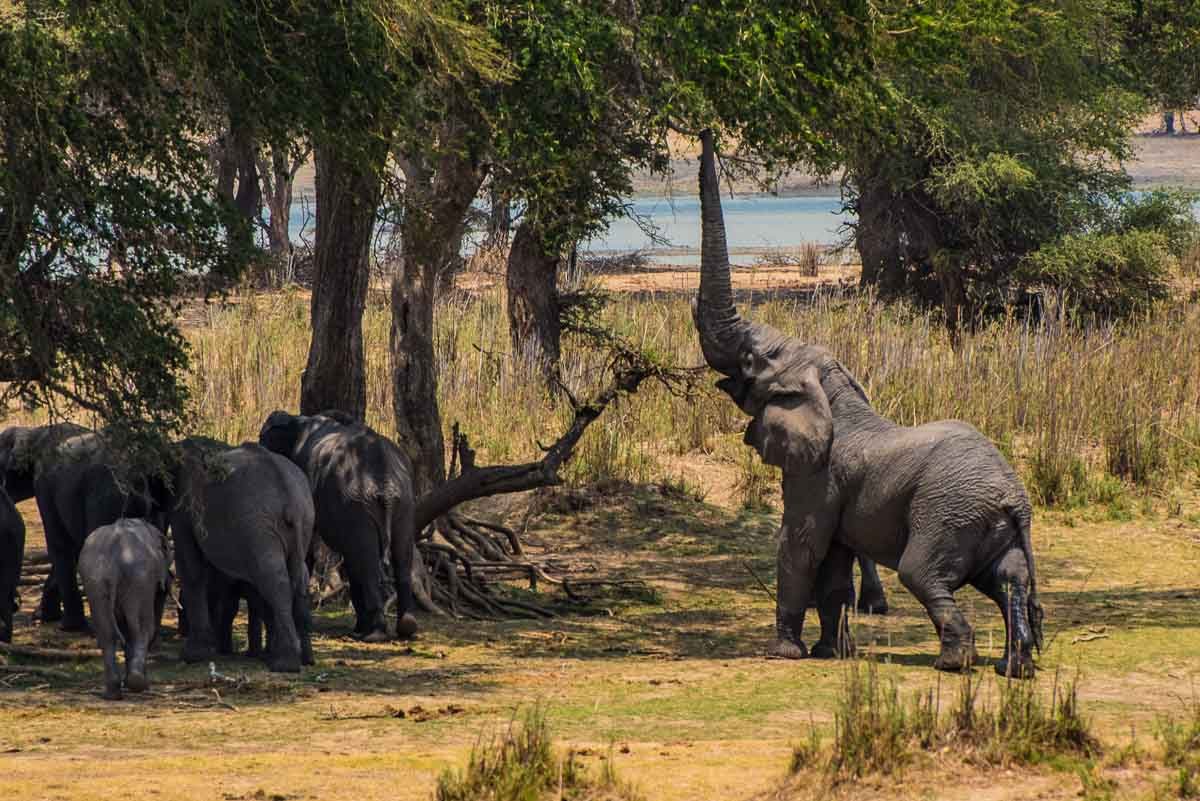
Day 5
The highlight of the beginning of today is the sighting of a ground hornbill, which we are told are extremely rare and very endangered, mostly because they are very slow breeding. They only lay one egg every 2-5 years.
The activity today is the “large mammal transect” where we drive five kilometers out on a bush road, and then walk a five kilometer transect into the bush. Today, our guard is Nathan, who along the way kindly tells me that I’m a “compass expert” because I know how to orienteer by spotting landmarks at the compass bearing we’re using (due east) and keeping the group on track by walking toward a certain hill in the distance. Nathan needs no compass or GPS to know where he’s going.
We do our five kilometers though the low dry foliage in to a shady grove, but only see two small groups of baboons the whole way. A long stretch of the hike is over burnt terrain, which oddly features burnt grass, but has spared the taller bushes and trees. Alex, our leader today, explains that the grass is so sparse, and burns so fast, that the heat isn’t enough to ignite the trees. The hard part of the walk is the slowness of the pace. We have one camper who hasn’t brought long sleeved shirts or other protective clothes against the sun. So, she’s wearing a long silky shawl, which catches on every bush we pass and means we have to stop to untangle her about every 20 yards.
The bush is just thick enough to require me to check our direction periodically, because there is no visible landmark we can see to mark the the way back. I see Nathan once looking bemused at my stopping to check, so I ask him what direction we were going. “Due west,” he says. He is right. And as we came out of the bush to the road where we’ve parked, we were right at our truck. Nathan does this without once checking anything but his innate sense of our direction.
Our afternoon activity is going out to the bush again, this time with Karen, to set butterfly and insect traps to catch subjects for later study.
The butterflies are attracted by hanging a plate with smashed overripe bananas, with an overhanging fine net that will prevent them from flying off after their feast. My partner on this activity didn’t like smashing up the banana with her hands–being a self-described “city girl.” So, I let her use my knife. When Karen checks our “work” she doesn’t like the degree of smashing on the bananas, so kneads them a bit herself with her fingers, and then wipes her fingers on her jeans.
The second method of collection is making “deadfalls” by digging a line of holes in the hard ground and installing deep plastic cups that crawling insects will fall into. That proves to be much harder than the butterfly traps, because the ground, which hadn’t seen rain for months, was impossible to dig in with the inadequate tool Karen had brought. Luckily, our Malawian guard was a little more persistent and used to Malawian concrete dirt, and dug all the holes for Karen.
Day 6
I don't go on any transect today, because honestly I just needed some alone time and wanted to catch up on my notes. So, I sit in the shade of the veranda, do a little reading (Out of Africa) and spot animals on the bank of the lake using a powerful spotting scope generously provided by a fellow camper.
I see about 20 impalas feeding in the grass and am impressed at what graceful animals they are. Two of them have arrived in the grazing area at full speed from the bush north of the lake. It's the first time I've seen an impala run. Grace personified.
As I sit, I am startled by a loud bang, and realize a baboon has climbed a tree near the veranda and jumped from there onto the corrugated steel roof of our kitchen. Scares the hell out of me, as I initially think it was a gun shot and that our camp guard has shot a lion that was about to eat me.
The highlight of my morning is watching baby warthogs and baby baboons chasing each other around the dried mud flats at the end of the lake. Baby warthogs are so cute, until they grow up.
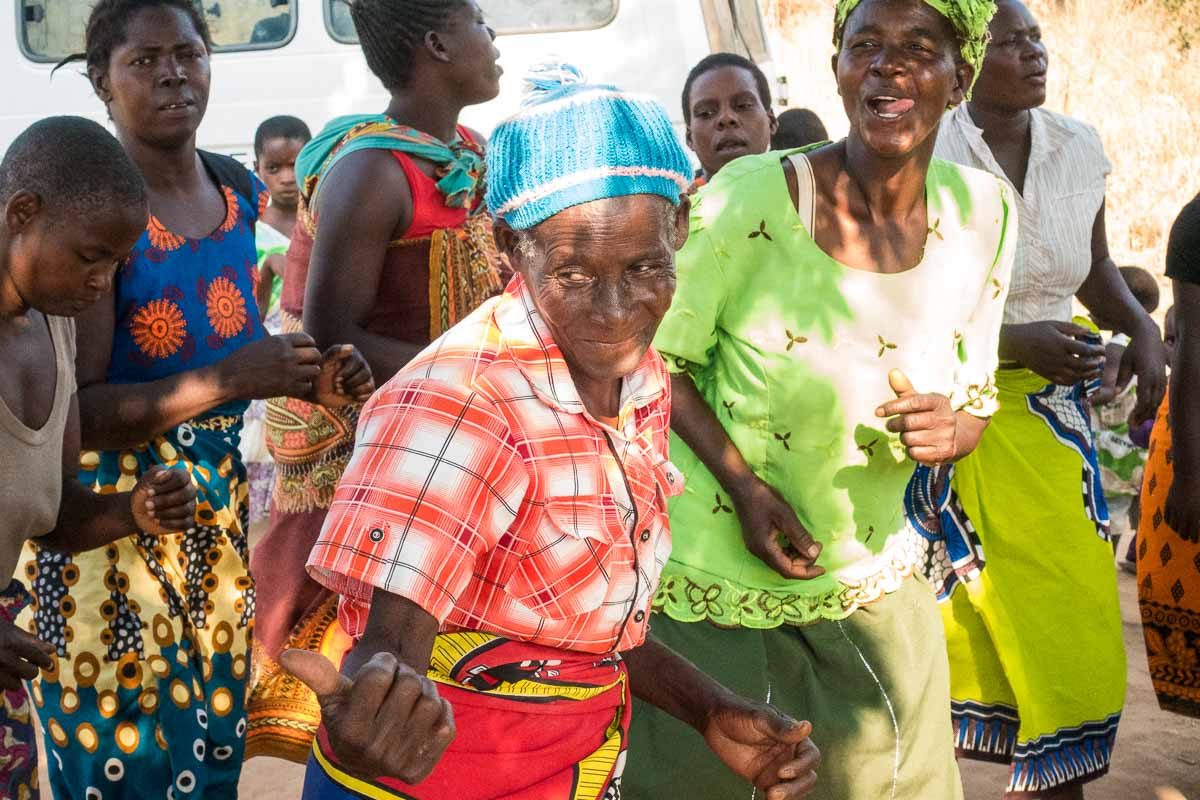
Day 7
Today is our “day off” and most of us go into a nearby village to meet the people, share some gifts we’ve brought, and do some dancing. I’ll just say about that that I shouldn’t be allowed to dance with people who have been doing it all their lives and have beautiful practiced rhythmic steps ingrained in their culture. I think I have less dancing ability than a hippo.
We get a tour of the “demonstration” village, which oddly was built as kind of an exhibit of village life for visitors. Perhaps the real village would be something too “shocking” for us, but I’m not sure.
We are shown the school, where we sit on very rough child-size stools and listen to the village leader welcome us in his language. Our cook, Emmanuel, does the translating. We are then led on a tour of some of the exhibit buildings: stables, a home, some more homes, grain storage, animal corrals, and more. The fields around us are under preparation for the coming rainy season but look as though, even with water, they weren’t going to yield much.
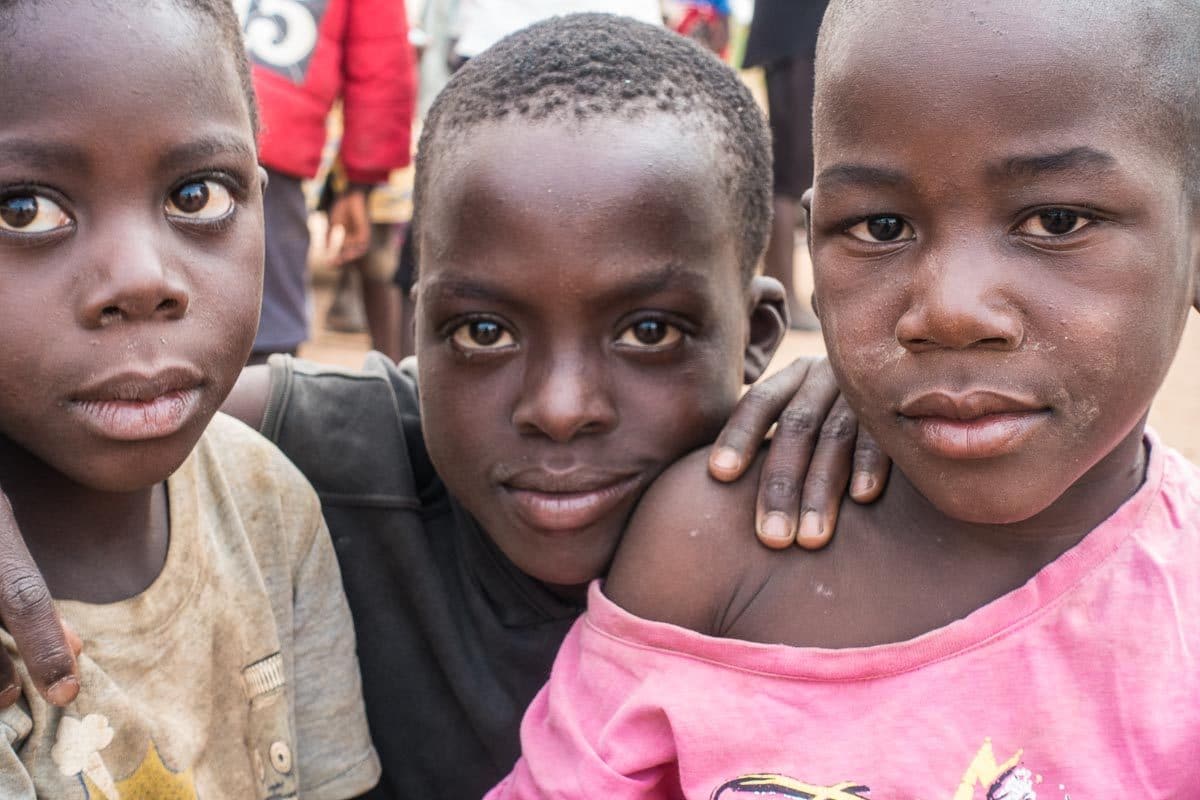
We eventually are led back to the open area under a big tree where the dancing starts. Three men drum, while about 30 women dance and sing. The teenaged boys ignore these festivities and play soccer on a field behind the clearing. Eventually we all were coaxed into to joining in, although it becomes quickly obvious that dancing here is only a female thing, and I use that excuse to drop out and take pictures.
There are few young men in the village. And fewer younger women that you would expect given the large number of children milling about the celebration. We are eventually told that many of the young people die from AIDS. Later, I look it up and read that Malawi has one of the highest birth rates in the world, and one of the highest rates of HIV infection.
Day 8
I do another hippo walk today and see another big croc out of the water. We haven’t seen elephants for two days, since we got a very brief afternoon rain on day 6. Pili opines that they have moved further north, where the rain fell more strongly, looking for the new shoots and grass the rain would have brought forth.
As we are halfway along the walk along the north of the lake, we find a blood trail. We follow it into the bush until we lose it, but find no wounded animal. Pili guesses it was probably one of the antelopes that had been wounded in a male supremacy battle. There are no drag marks, which we would see if an animal has been killed by a large predator. Later that afternoon, we see a wounded impala in the grass in front of camp.
As we return to camp, Brutus the big elephant crosses our path behind us. We know it is him because he’s huge and has one broken tusk. Because he is not between us and the camp, we don't have to detour this morning.
In the afternoon, we do camera trap analysis, searching through all the memory cards of the cameras that had been collected by another group yesterday. There are a lot of “blank” images caused by brush blowing in the wind setting off the motion sensors, but we collect all the animal images, record their times in the computer program, and move the images to separate folders.
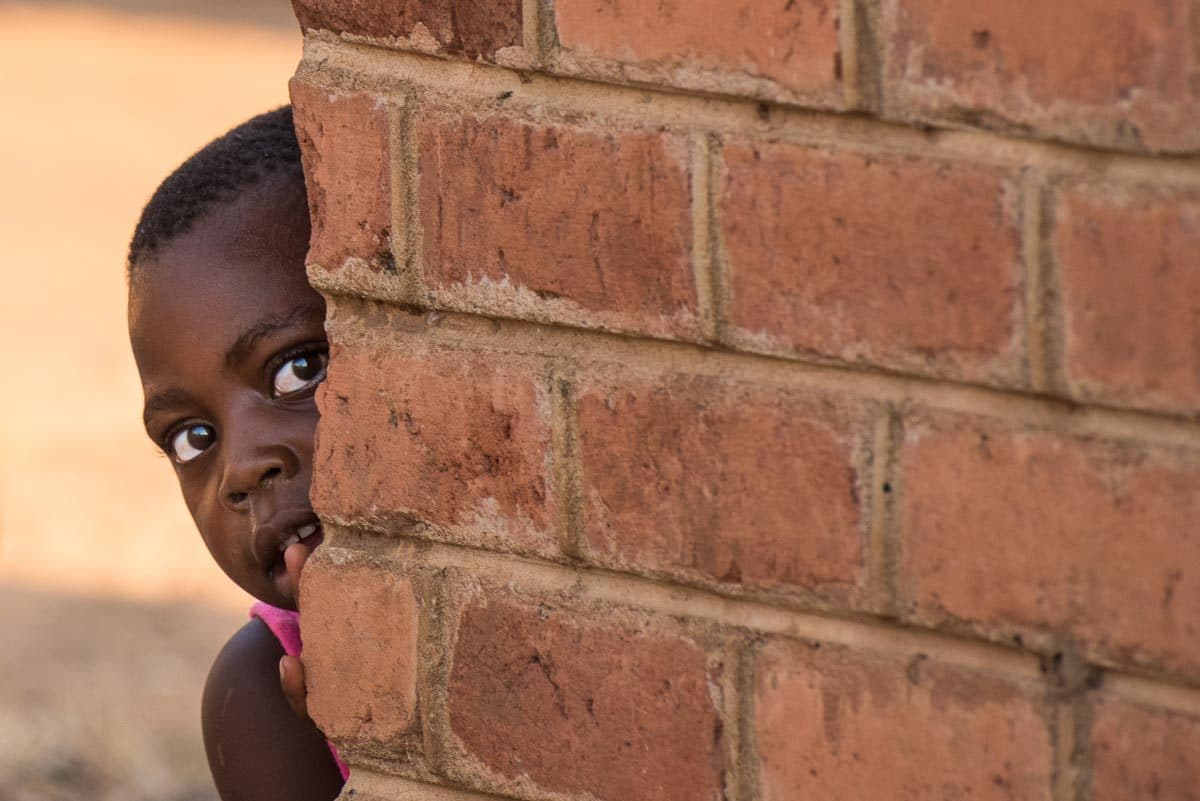
Day 9
My contribution for the day is going on baboon observation with Mandy, the primatologist. We walk to the village up the hill where the game reserve staff and their families live, and the baboons hang out looking for handouts and whatever they can steal. The baboon observation technique is to watch them for two minutes on, two minutes off, and record behaviors such as foraging, feeding, walking, playing, mating, etc. We pair up and one person observes and calls out the age, sex, and behavior and the other records on the clipboard. We spend a couple hours doing this, until we decide we’re getting too hot. The children of the village like to follow us around and play hide and seek.
Day 10
Today’s morning activity is a driving transect, where we make our now customary five-kilometer runs, but in a truck. Most of the campers stand in the back of the truck, holding on to bars put there for that purpose and calling out sightings. Our new experience of the day is being persistently attacked by tsetse flies who don’t seem to mind at all that we’re covered in DEET. I bought an insect head net just for this, but stupidly leave it in my tent instead of loading it into my day pack. We all spend more time swatting the air with our hats than looking for animals. Some of the campers are wearing clove oil and testify that that worked against the tsetses. Now they tell me.
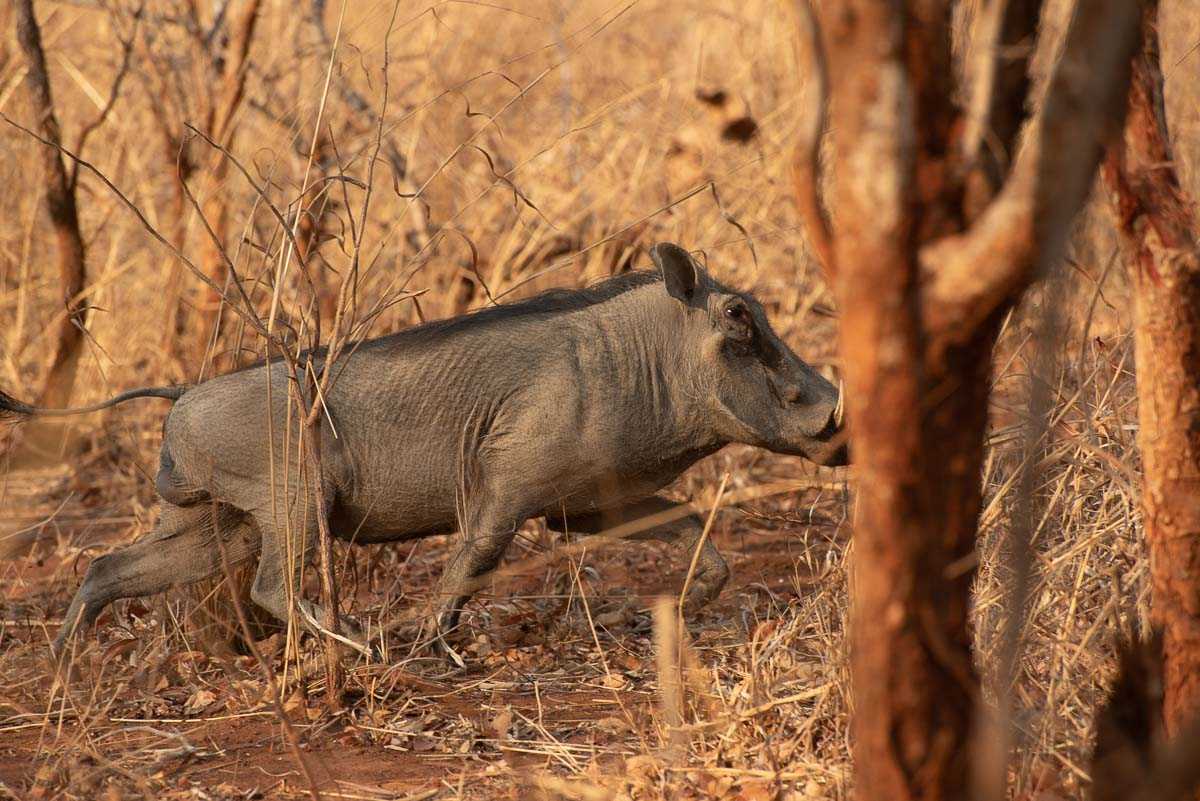
The only animals we see in about 135 kilometers and seven hours of driving are a few warthogs, but we do pick up some more leopard scat, as well as hyena droppings. The hyena droppings are white, because of all the calcium in the bones they eat.
We drive through three grass fires. We don’t know if they are natural, or set by poachers who hope that the fires will engender new grass growth, which will attract antelopes.
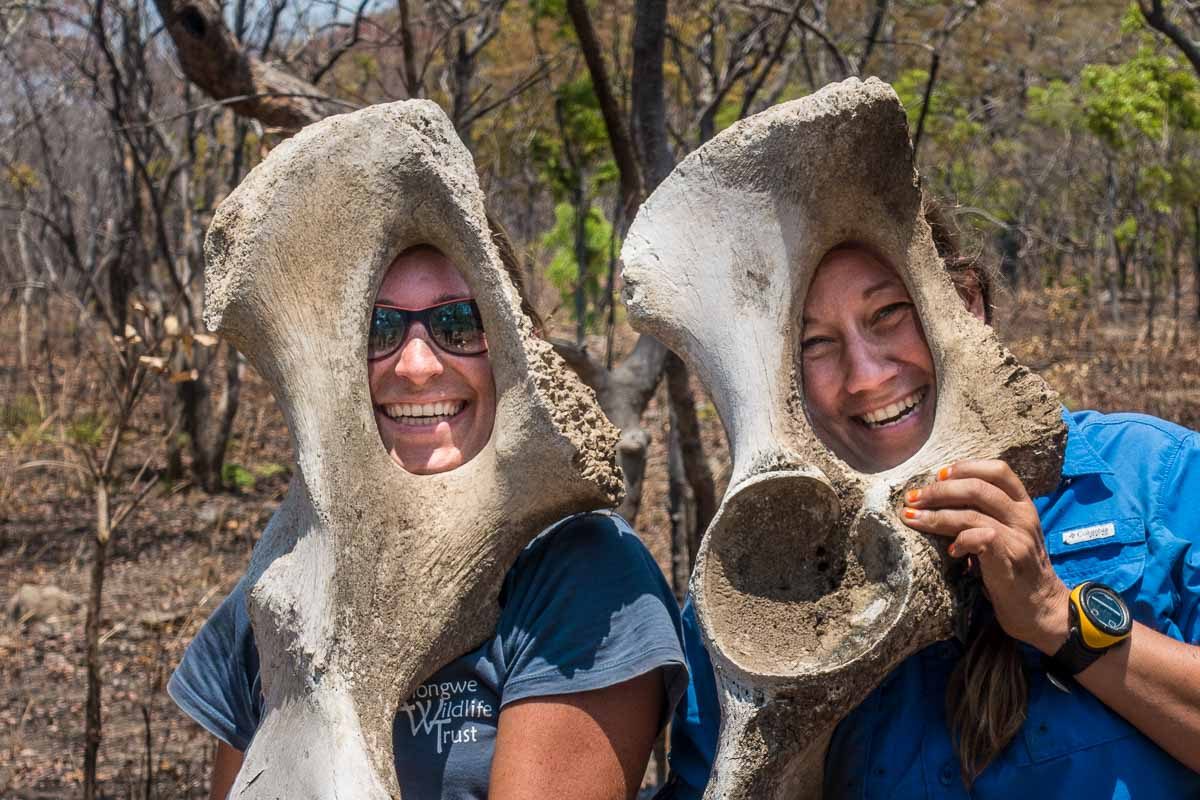
We find an elephant skeleton in the bush that looks like it had been there for quite a while, it was completely bleached by the sun, and, of course, the tusks were gone. No telling if this is the work of poachers, or if the elephant has died naturally. If it wasn’t poachers who collected the tusks, it would have been done by the park rangers.
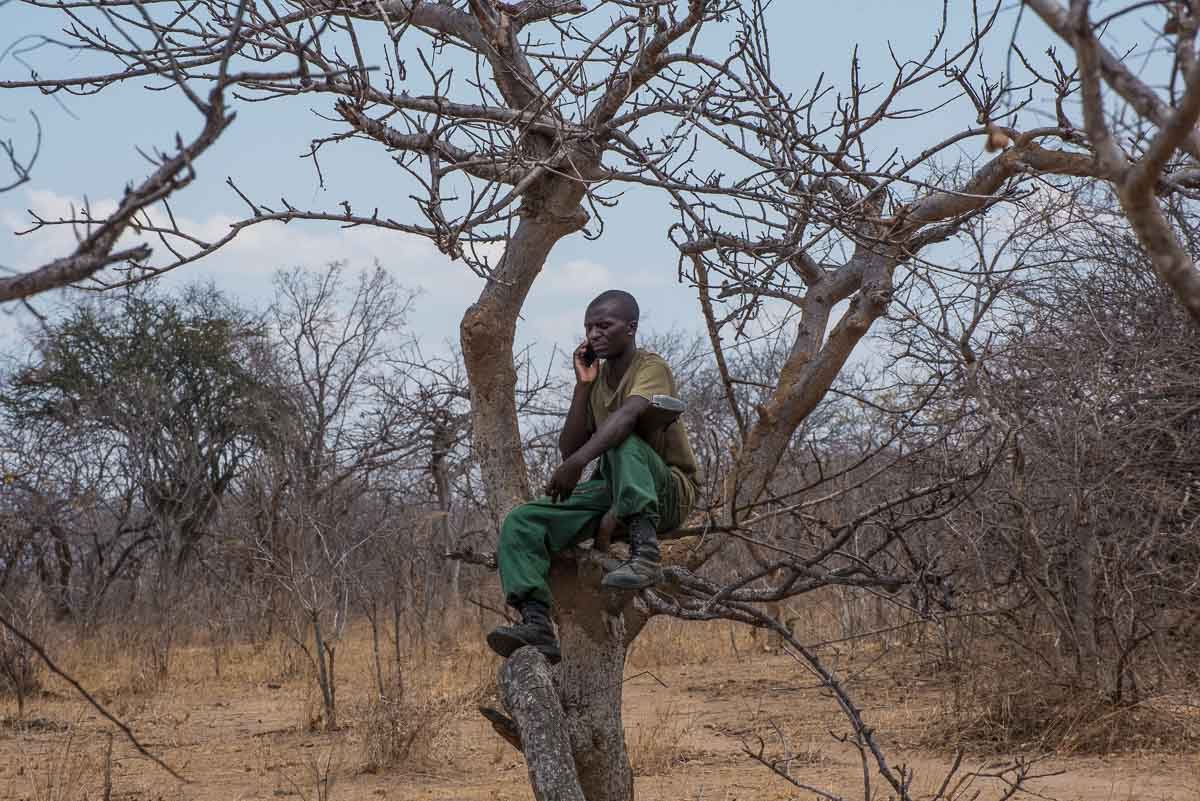
Day 11
I start on another hippo walk this morning, but leave the group and come back to camp on my own after just a few minutes. I have decide I need another day off to again catch up on my notes and watch animals through the scopes on the veranda. I do pitch in on data entry into the computers, which is a necessary, albeit boring, aspect of the research.
In the afternoon, we go on a vegetation survey, which is an adjunct to the insect and bat science. We return to a location where our resident bat man, Andrew, has collected bats the night before, in order to do a detailed vegetation count of literally every tiny branch on every short bush along a 50-meter line. Really. The vegetation has something to say about how the bats can navigate the territory and how much insect cuisine they’re likely to find.
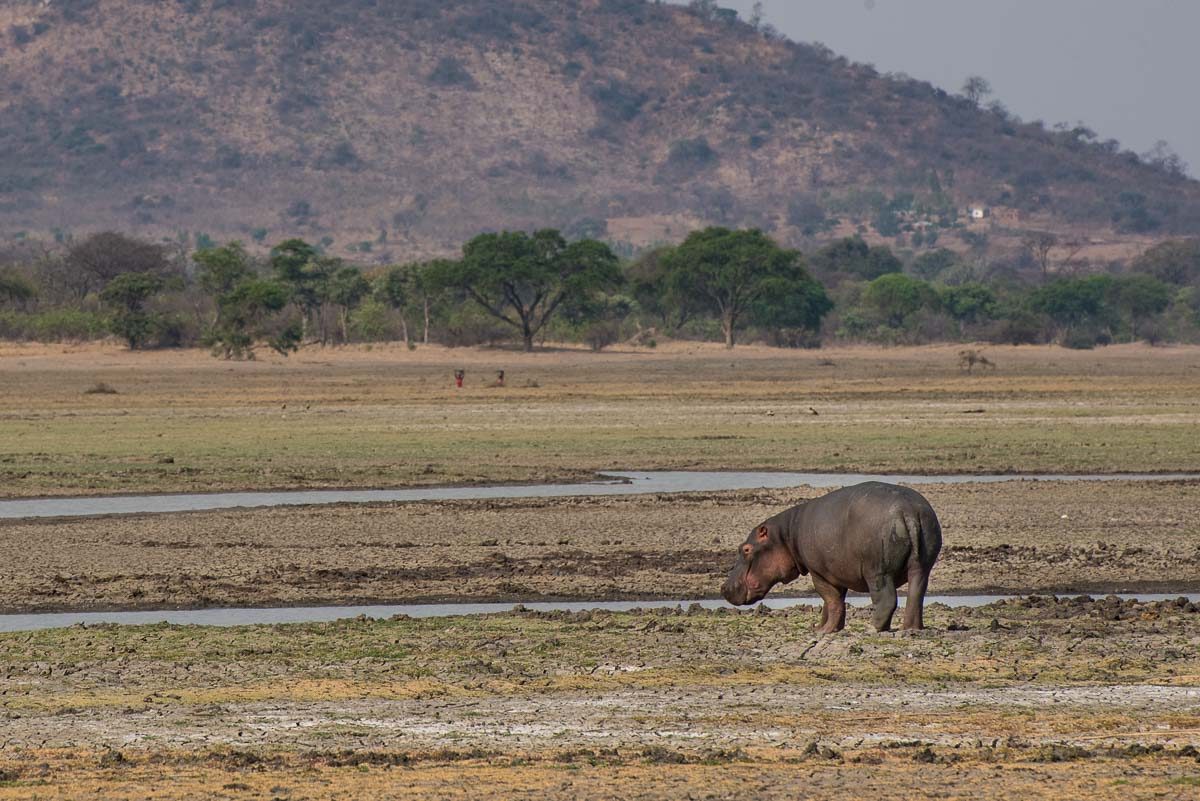
Day 12
Today, another morning hippo walk with a little unexpected excitement. When we are just a few hundred meters from camp, Nathan, our guard again today, gets a phone call from a woman who was out gathering firewood in the bush. She’s discovered a dead bush buck. We track into the bush with Nathan, where we find the bush buck. He hasn't been dead long. When Nathan rolls him over, we can see he’s been shot in the chest. He evidently had been able to survive his wound long enough to run into the bush where his hunter couldn’t find him at night. Some of us heard a shot in the night before that was probably been the one that killed him.
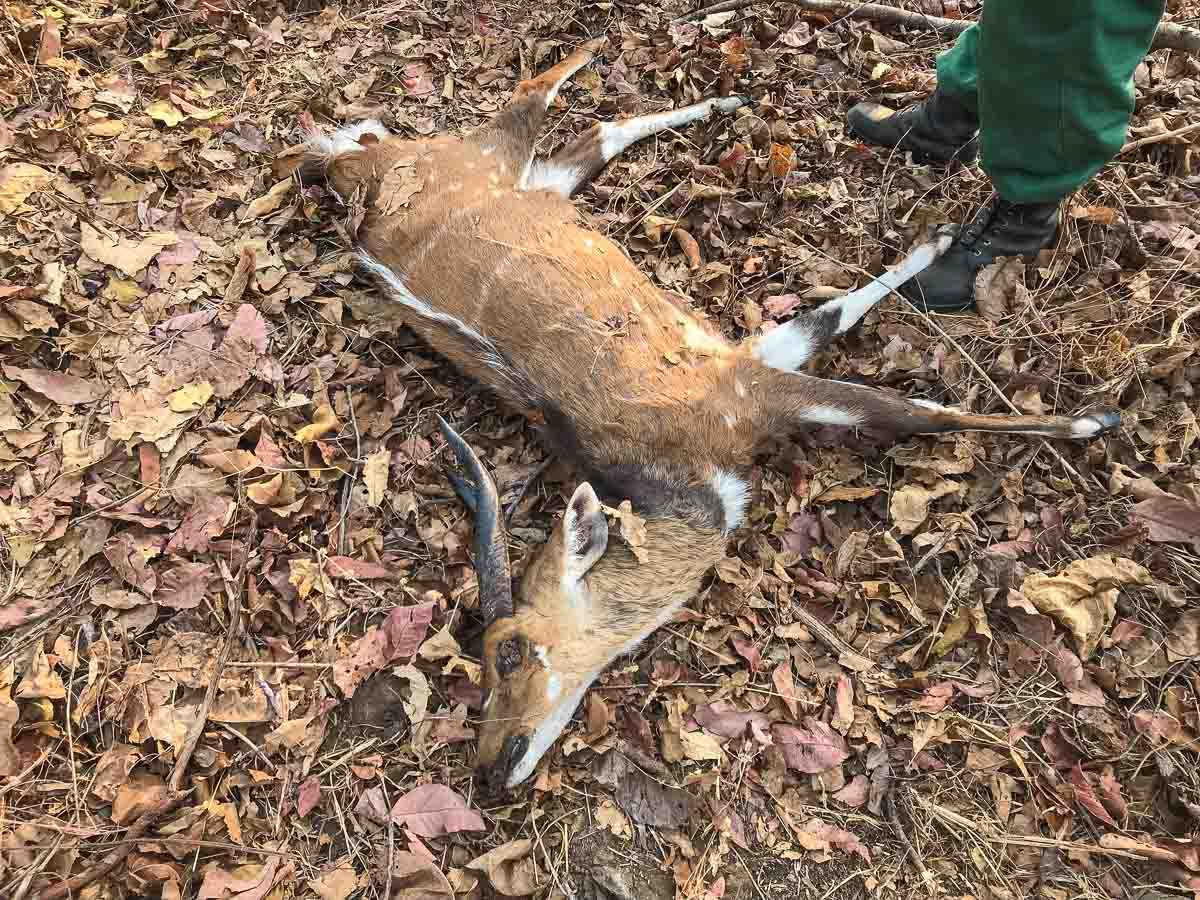
Today we see our first hippos out of water and so have to make a few roundabout hikes to complete our five kilometers while giving them a wide berth. For a while we are followed by a lone elephant, and Nathan leaves his normal spot at the head of our small parade to put himself on our flank on the bush side between us and the elephant. He unslings his M-14 rifle from his shoulder and carries it in his hand.
Eventually, we have to leave our lakeside route and again head into the bush and up to the high road to avoid elephants coming down to the water to drink. We end up in a bit of a standoff, as a small group of elephants stop their road crossing ahead of us because they’ve noticed us. Of course, we can't pass close in front of them without spooking them further. We back up the road to wait for them to cross, but they just linger in the trees. We eventually have to call back to the camp to be picked up by one of the trucks.
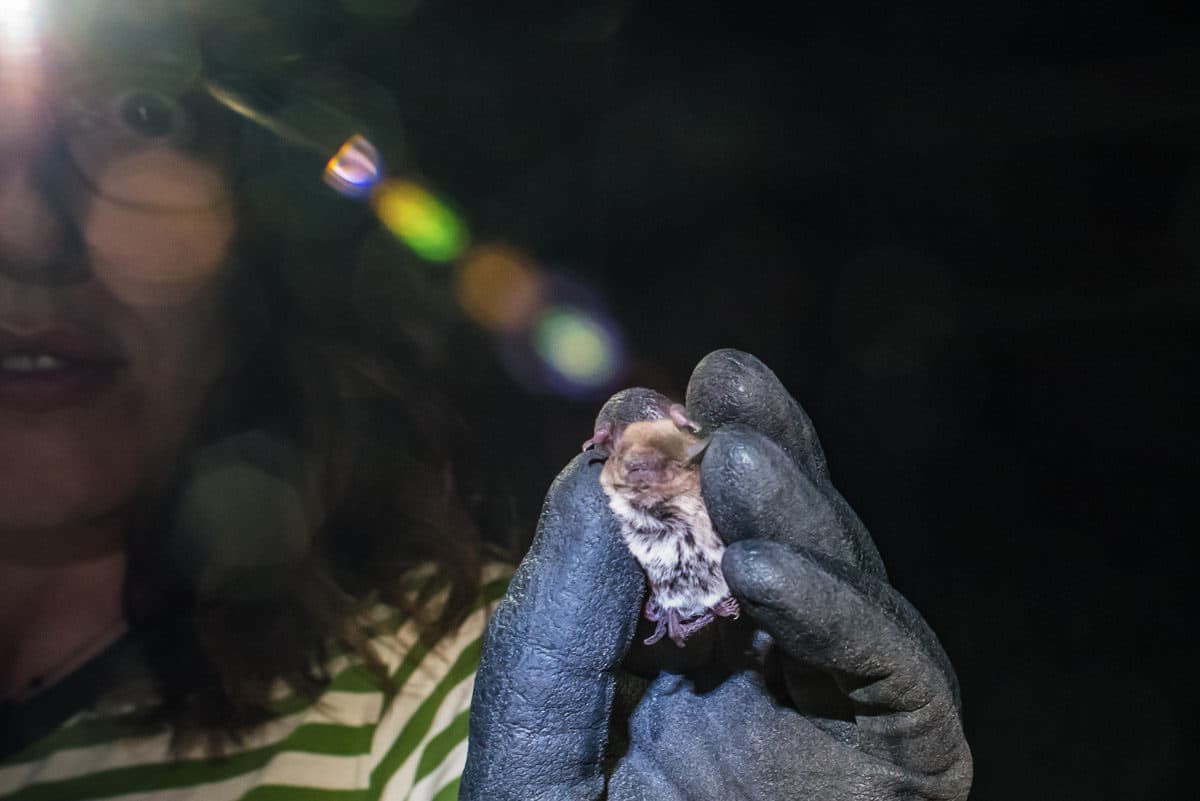
The night time tonight is my first contact with the bats that other groups have been collecting on their nighttime forays into the bush. This night, the nets have been set very close to the camp, and by early evening, they’ve collected a couple dozen bats.
It is an education to watch Karen and Andrew retrieve them from the collection basket, and examine them for species, sex, size, and wingspan. I had no idea how tiny these sorts of bats are. Smaller than some of the insects we collected.
This is our final night in camp, and I’m glad I finally made the effort to at least peripherally participate in the bat collection.
What I’ll remember about my Biosphere Expedition in Malawi
This is perhaps the longest post I’ve ever written for Travel Past 50, but even at nearly 5000 words, I’ve left out some details.
For example, the elephant and hippo footprints left over from last year’s rainy season that were now petrified into the cracked mud lakeshore.
Nathan sitting on a tree branch while we counted the number of branches on the local bushes.
Emmanuel and Pili telling me about the price needed to pay to the father of a Malawian bride. In the wealthier south of the country, it could be two cows. In the poorer north, a hoe to furrow the poor fields.
Pawing through elephant dung to count seeds of the plants they were eating. I didn't do this myself, but got a kick out of watching others.
A spider at the breakfast table the size of your fist. The throb of the drums in the village we visited, and the modern pop music that wafted over the lake from another village at night.
Seeing an anteater, a hyena, a serval, and porcupines on the capture cameras.
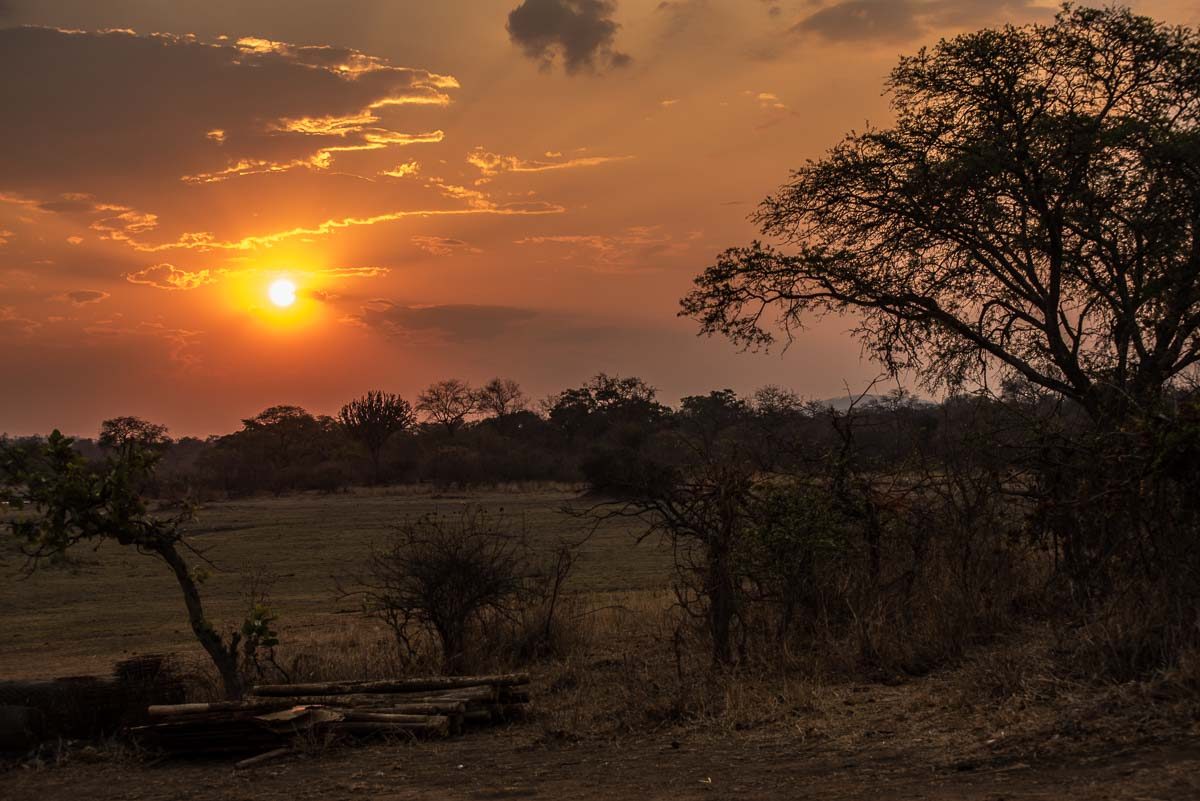
And the sunset every night.
All these details are what made me love this experience as much as I did. It was my first visit to sub-Saharan Africa, and the Biosphere Expeditions approach to animal observation is unique and unsurpassed. Their organization, work, concern for the environment, concern for their campers’ experience, and the choice of a location in remote Malawi all added up to a unique and fulfilling trip. I want to go back already.
You can read more about my trip to Malawi with Biosphere Expeditions in this post.
Before you venture into the African bush, be sure to read our packing list for Africa.
For a great article on how to photograph animals on an African safari, check out this guest post by our friend Susan Portnoy of The Insatiable Traveler. Susan is, for my money, one of the best wildlife photographers out there.
And, never undertake a trip like this without taking out travel insurance.
You can hear more about working as a citizen scientist in Africa in these two interviews with a primatologist and a fellow citizen volunteer.
You can click the link above, or use this widget below to start the process of getting a visa for any country.
Up Your Travel Skills
Looking to book your next trip? Use these resources that are tried and tested by us. First, to get our best travel tips, sign up for our email newsletter. Then, be sure to start your reading with our Resources Page where we highlight all the great travel companies and products that we trust. Travel Accessories: Check out our list of all the accessories we carry to make getting there and being there a lot easier. Credit Cards: See our detailed post on how to choose the right travel rewards credit card for you. Flights: Start finding the very best flight deals by subscribing to Thrifty Traveler. Book your Hotel: Find the best prices on hotels with Booking.com. See all of the gear and books we like in one place on our Amazon shop.Got a comment on this post? Join the conversation on Facebook, Instagram, or Threads and share your thoughts!

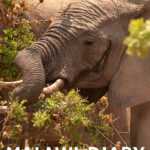

Comments are closed.